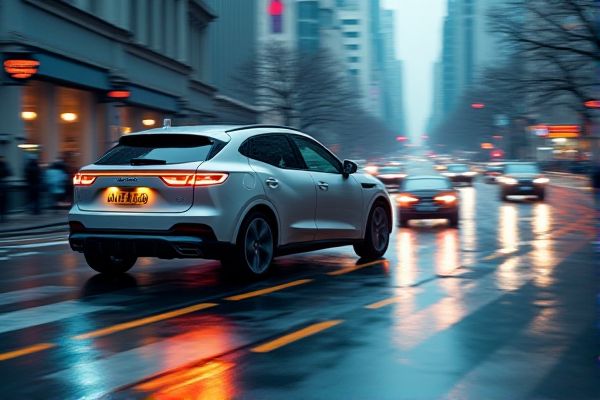
AI technology enhances urban mobility through real-time traffic management systems that analyze data from sensors and cameras to optimize traffic flow. Smart public transportation solutions leverage AI algorithms to predict demand, improve scheduling, and ensure efficient route planning. Autonomous vehicles, utilizing AI, can communicate with traffic infrastructure to reduce congestion and increase safety on the roads. Ride-sharing services employ AI to match drivers and passengers effectively, minimizing wait times and enhancing user experiences.
AI usage in urban mobility
Autonomous Vehicles
AI in urban mobility can enhance traffic management and decrease congestion. For example, autonomous vehicles like those developed by Waymo could optimize routes based on real-time data, potentially leading to shorter travel times. This technology may also improve safety by reducing human errors, which are a significant factor in accidents. The integration of AI systems in public transportation could further create efficiencies, making it a viable alternative to personal vehicles.
Traffic Management Systems
AI can optimize traffic flow in urban mobility by analyzing real-time data from traffic cameras and sensors. Traffic Management Systems equipped with AI can predict congestion and adjust signal timings accordingly, potentially reducing travel times for commuters. Implementing such systems in major cities like New York could enhance overall efficiency and improve air quality. The possibility of integrating AI with public transportation can further create a seamless travel experience for citizens.
Ride-Sharing Optimization
AI can enhance urban mobility by optimizing ride-sharing services, potentially reducing wait times and improving route efficiency. Companies like Uber have begun to leverage AI algorithms to analyze traffic patterns, which can lead to better service delivery. This optimization may result in lower operational costs for ride-sharing providers and increased convenience for users. As cities adopt smart transportation systems, the chance for such integrations can lead to a more sustainable urban environment.
Predictive Maintenance
AI usage in urban mobility can enhance traffic management and reduce congestion, leading to more efficient transportation systems. Predictive maintenance allows public transportation fleets to identify potential issues before they become critical, minimizing downtime and repair costs. For example, cities like Los Angeles are leveraging AI to optimize bus routes and schedules. The integration of these technologies may improve overall commuter experience and reduce environmental impact by promoting public transit use.
Pedestrian Safety Enhancements
AI can improve urban mobility by optimizing traffic flow and reducing congestion. For instance, smart traffic signals can adapt in real-time, enhancing pedestrian safety at busy intersections. This technology may lead to fewer accidents and a more comfortable experience for users. Cities implementing these AI systems, like San Francisco, could see significant benefits in public safety and operational efficiency.
Route Optimization
AI applications in urban mobility can enhance route optimization for public transit systems. By analyzing real-time traffic patterns and commuter behavior, cities can improve efficiency and reduce travel times. For example, services like Google Maps leverage AI to suggest the fastest routes, benefiting both commuters and transportation agencies. Innovations in this area may also lead to fewer emissions and better resource management in urban environments.
Real-Time Data Analytics
AI usage in urban mobility can enhance efficiency by providing real-time data analytics that optimize traffic flow. Cities like San Francisco utilize these technologies to improve public transport schedules and reduce congestion. The integration of AI can lead to better resource allocation, which may allow for increased ridership and satisfaction. With ongoing advancements, there is potential for even greater improvements in urban transport systems.
Smart Public Transportation
AI can enhance urban mobility by optimizing public transportation routes and schedules. For instance, cities like Barcelona implement AI algorithms to analyze real-time traffic data, improving efficiency and reducing wait times. This technology increases passenger satisfaction and can lead to higher ridership rates. Smart public transportation systems also have the potential to lower operational costs for institutions managing transit services.
Energy Consumption Reduction
AI applications in urban mobility have the potential to significantly reduce energy consumption by optimizing traffic flows and improving public transportation efficiency. For instance, smart traffic management systems can analyze real-time data to minimize idling times, ultimately lowering fuel usage. Such advancements may lead to enhanced commuter experiences and decreased emissions. Cities adopting these technologies, like San Francisco's approach to smart transit, could see meaningful improvements in overall energy sustainability.
Urban Infrastructure Monitoring
AI in urban mobility can enhance traffic management and reduce congestion by analyzing real-time data from various sources. Through urban infrastructure monitoring, AI can identify maintenance needs and optimize resource allocation, potentially prolonging the lifespan of roads and bridges, as seen in cities like Sensor City. The integration of smart sensors can lead to improved public transport schedules, making commutes more efficient. Overall, leveraging AI holds promise for transforming urban environments into more sustainable and livable spaces.
 techknowy.com
techknowy.com